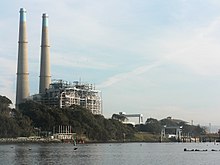Moss Landing Power Plant
36°48′17.54″N 121°46′55.19″W / 36.8048722°N 121.7819972°W



The Moss Landing Power Plant is a natural gas powered electricity generation plant located in Moss Landing, California, at the midpoint of Monterey Bay. The plant's large stacks are landmarks, visible throughout the Monterey Bay Area. In 2013, the plant could produce 2484 MW.
History
The building of the Moss Landing power plant began in 1949 with the first five units. Producing 560 MW, these units started commercial generation in 1950. After 45 years of production, the original five units were decommissioned in 1995.
In 1964, the construction of two additional units began (6 and 7), with two new 500-foot (150 m) stacks. These two units produce 750 MW each, with boilers that are 180 feet (55 m) tall. They employ a newer technology using supercritical steam at 3,600 psi (25 MPa).
The generation process for units 6 and 7 starts with natural gas injected at one end of the boiler to be burned. Primary water is injected at the other end of the boiler to receive the heat produced. The gas simply comes from a natural gas pipeline, and combustion products go up the stack and into the atmosphere.
Water has a much more complicated path, and consists of two distinct systems: coolant water and primary (steam-generating) water. Cooling water is pumped out of the Monterey Bay or the nearby Elkhorn Slough. Then it is purified, used to cool down the water coming from the turbines, and discharged into the ocean. Steam for the turbines is created from the primary water flow, which is preheated before entering the boiler. From the boiler, the superheated steam is directed into a first turbine working at high pressure, then into a low pressure turbine. The turbines drive the generators.
To comply with more restrictive pollution regulation, units 6 and 7 were upgraded in 1998 with a selective catalytic reduction unit and digital control systems.
Starting in 2000, the eight 225-foot (69 m) stacks and 19 fuel oil storage tanks were removed, and two new units were built on the former site.[1] The new units 1 and 2 were brought online in 2002. They are combined cycle units, 50% more efficient than the other units. because they use two turbines: first, a pair of 170 MW gas turbines, then a 190 MW steam turbine, for a total of 530 MW each.
Combustion products drive the gas turbines directly. First, air is drawn from the air intake to the compressor (driven by the turbine axle), then it is burned with natural gas in the combustion chamber. The hot combustion gasses then go through the actual turbine (driving the axle). From a thermodynamic standpoint, this is the standard Brayton cycle. Because the gas turbine does not transfer energy from the combustion process to the turbine via steam, it avoids the cost, energy loss and environmental impact of the primary water cycle.
At the output of the gas turbines, some of the remaining energy (heat) in the exhaust gas is recovered through a heat exchanger and transferred to water that feeds a steam turbine, similar to units 6 and 7.
On a smaller scale than the supercritical units, units 1 and 2 are also more flexible, with a start-up time of only an hour, against 24 hours for units 6 and 7.
The Moss Landing power plant has a maximum capacity of 2560 MW, but the older, less efficient, supercritical units 6 and 7 are only operated during the peak period between June and September.
Some of the power generated from the plant is sent to far-away regions via Path 15, directly connected to the plant, and interconnections like Path 26 and Path 66.
The Moss Landing power plant was built and owned by Pacific Gas and Electric Company. As part of California's experiment with energy deregulation, PG&E sold it to Duke Energy (DENA) in 1998. In 2006, having invested over half a billion dollars in upgraded capacity, efficiency and emission control, Duke Energy sold the plant to LS Power Equity Partners.[2][3] Dynegy of Houston, Texas then purchased the plant in April 2007 along with other assets of LS partners.[4]
Each day, roughly 1,200,000,000 US gallons (4,500,000 m3) of water are cycled through the power plant.
References
- ^ Duke Energy Breaks Ground on Moss Landing Modernization Project
- ^ "Duke Energy Completes Sale of Wholesale Generation Assets to LS Power". press release. May 4, 2006. Retrieved February 16, 2011.
- ^ "LS Power Closes Deal for Duke Assets". press release. May 4, 2006. Retrieved February 16, 2011.
- ^ "Dynegy Announces Completion of LS Power Transaction". press release. April 2, 2007. Retrieved February 16, 2011.
